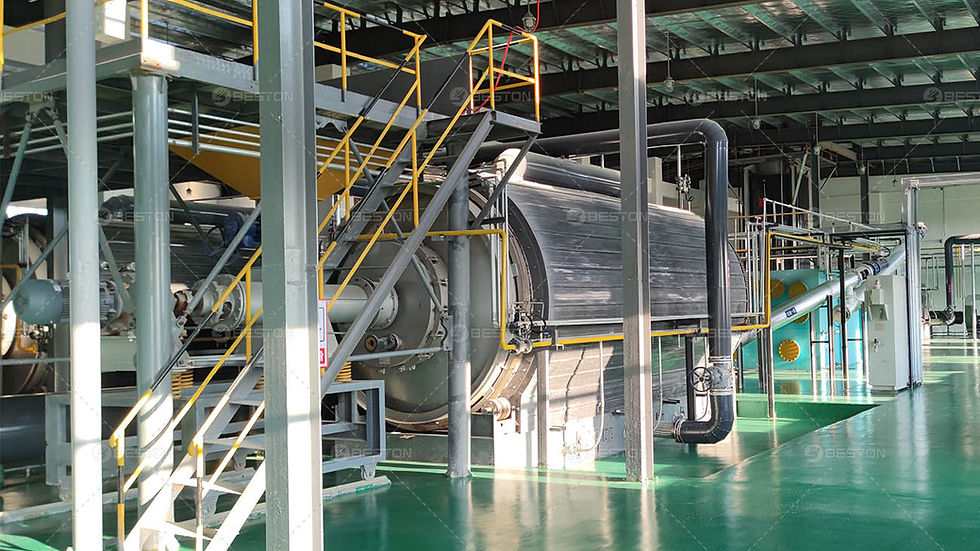Advantages of Small Pyrolysis Plant
- wastetoenergy
- Jun 18, 2024
- 3 min read
In the realm of sustainable waste management and energy production, the small pyrolysis plant stands out as a compact yet powerful solution. This innovative technology converts various organic materials into valuable products through thermal decomposition in the absence of oxygen. Here, we delve into the manifold advantages offered by a small pyrolysis plant.
Understanding Small Pyrolysis Plant
A small pyrolysis plant operates on the principle of thermolysis, where organic substances are decomposed at elevated temperatures in a controlled environment. This process yields three main products: biochar, bio-oil, and syngas. Each of these products holds significant value in diverse industrial applications and environmental initiatives.
Key Advantages
1. Versatility and Flexibility
Small pyrolysis plants are highly versatile, capable of processing a wide range of feedstocks including biomass residues, agricultural waste, plastics, and tires. This flexibility enables them to adapt to varying feedstock availability and local waste management challenges.
2. Compact Footprint
Unlike larger industrial pyrolysis facilities, small pyrolysis plant has a compact footprint, making them suitable for decentralized deployment. This characteristic is particularly advantageous in urban settings or remote areas where space is limited and waste management infrastructure is sparse.
3. Resource Recovery
The pyrolysis process efficiently converts organic waste into valuable resources:
Biochar: A stable carbon-rich material that enhances soil fertility and carbon sequestration when used in agriculture.
Bio-oil: A versatile liquid fuel that can be further refined into biofuels or used as a feedstock for chemical synthesis.
Syngas: A mixture of hydrogen, carbon monoxide, and methane that can be combusted directly for heat and power generation or further processed into synthetic fuels.
4. Energy Efficiency
Small pyrolysis plants are designed to maximize energy efficiency through heat recovery systems and process optimization. By utilizing the heat generated during pyrolysis, these plants can achieve high thermal efficiency and reduce overall energy consumption.
5. Environmental Benefits
Operating with minimal emissions and utilizing waste materials as feedstock, small pyrolysis plants contribute to environmental sustainability:
Reduction in Landfill Waste: By converting organic waste into valuable products, pyrolysis plants alleviate the burden on landfills and reduce methane emissions from decomposing waste.
Carbon Sequestration: Biochar produced during pyrolysis sequesters carbon in soils, mitigating greenhouse gas emissions and enhancing soil health.
6. Economic Viability
The compact size and modular design of small pyrolysis plants translate into lower initial investment costs compared to larger-scale facilities. This economic advantage makes them accessible to small and medium-sized enterprises (SMEs) and community-based initiatives seeking sustainable waste management solutions.

Practical Applications
- Waste Management: Small pyrolysis plants offer a sustainable alternative to traditional waste disposal methods by converting waste materials into valuable products.
- Bioenergy Production: Bio-oil and syngas produced by pyrolysis can be utilized for heat and power generation, reducing dependency on fossil fuels and promoting renewable energy sources.
Challenges and Considerations
While small pyrolysis unit offers numerous benefits, several challenges need to be addressed for optimal operation:
Feedstock Quality and Availability: The quality and consistency of feedstock significantly impact the efficiency and output of pyrolysis plants. Ensuring a reliable supply chain of suitable feedstocks is crucial.
Technological Optimization: Continuous research and development are essential to improve pyrolysis technologies, enhance product yields, and reduce operating costs.
Regulatory Compliance: Compliance with environmental regulations and standards governing emissions, waste management, and product quality is essential for sustainable operation.
Future Outlook
The evolution of small pyrolysis plant technology holds promise for expanding its applications and improving its efficiency:
Advanced Pyrolysis Techniques: Innovations in reactor design, catalytic pyrolysis, and process integration are poised to enhance product yields and energy efficiency.
Integration with Circular Economy: Small pyrolysis plants can play a pivotal role in circular economy frameworks by closing material loops, recovering resources from waste streams, and promoting sustainable consumption and production patterns.
Conclusion
In conclusion, small pyrolysis plants represent a significant advancement in sustainable waste management and renewable energy production. Their compact size, versatility, and ability to convert diverse feedstocks into valuable products make them an attractive solution for both environmental and economic sustainability. As technology continues to evolve and regulatory frameworks evolve, small pyrolysis plants are poised to play a pivotal role in transitioning towards a circular economy and reducing our reliance on finite fossil resources.
For more information on small pyrolysis plants and their benefits, feel free to reach out or explore further resources dedicated to sustainable technologies and waste management solutions.









Comments